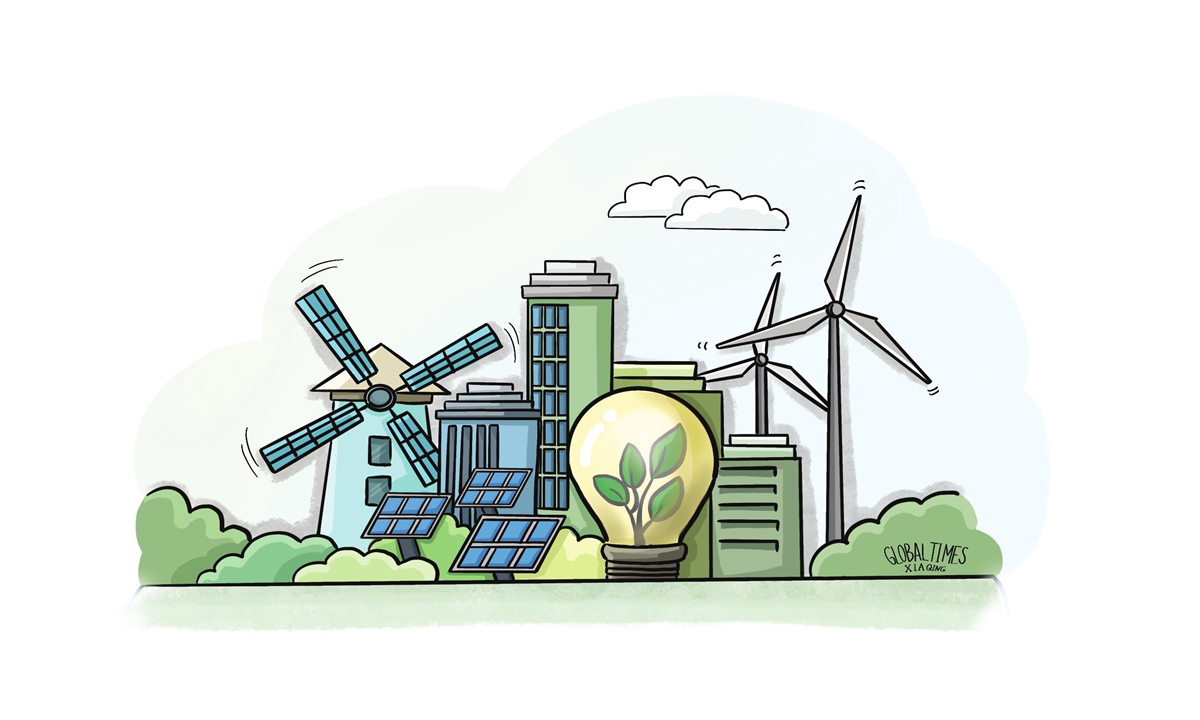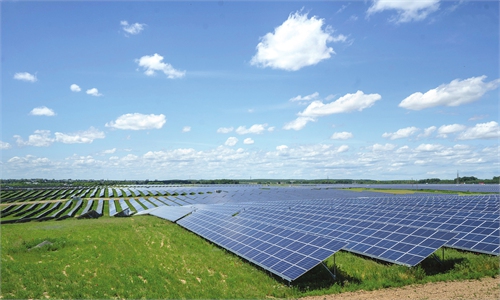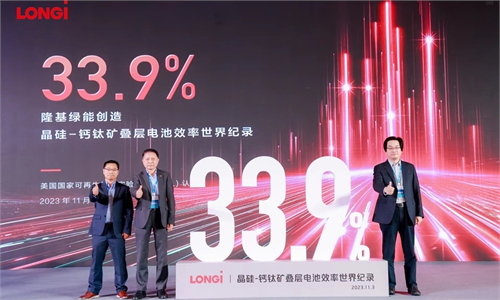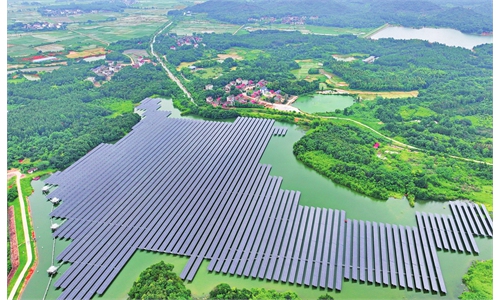High-tech, economic and policy incentives driving China’s efforts to combat pollution, climate change

Illustration: Xia Qing/Global Times
Blue skies and shining sun have returned to Beijing during the annual seasonal shift from autumn to winter, a time when the Chinese capital city used to be shrouded in thick smog or heavy haze in the 1990s and early 2000s. Thanks to the government's steadfast and strenuous efforts to reduce air pollution and cut greenhouse gas emissions, meaningful gains have been made in air quality today, benefiting the city's nearly 22 million permanent residents.The battle to clean up air in Beijing and other major Chinese cities has not been easy. More than a decade of hard work and sustained government investment appears to have finally paid off in improving the environment in the country and revamping the traditional industrial ecosystem by eliminating sources of pollution, such as intensifying the replacement of fossil fuels with renewable clean energy led by hydropower, solar panels, winter turbines and nuclear energy. The campaign has involved combating all sources of air pollution, from coal combustion to urban construction to household fuel burning.
Now, the annual average levels of hazardous breathable particles known as PM2.5 concentration in Beijing has dropped to less than 30 micrograms per cubic meter, down more than 66 percent from 2013 levels, according to Beijing Municipal Ecology and Environment Bureau. Despite the success, the city's "green momentum" will continue to gain pace in coming years, as the government's efforts are not to abate.
The linchpin of the extraordinary improvement in Beijing's air quality lies in the particular mix of effective policy, new technology and economic incentives that have manifested as China's comprehensive fight against atmospheric pollution and global climate change. Consequentially, China has been a pioneer in the world's green revolution, now leading in a wide coterie of new-energy and green-transport technology innovations.
Like other major cities including Shenzhen, Hangzhou, Chengdu and Shanghai, Beijing has also embraced "electric commute transformation." China is the global leader in campaigning for electric transit. In less than 10 years, Shenzhen has become the first city on the planet to replace all of its 16,500 public buses and cabs with emissions-free electric vehicles, followed by Hangzhou, Chengdu and Shanghai which are striving toward greener public transport system.
Beijing is on a similar change trajectory, electrifying about 70 percent of its public buses. Currently, sale of privately-owned electric cars has accounted for 37 percent of all vehicle sales throughout the country, marking the highest penetration rate in the world. It is true that fossil fuel-burning "dirty" vehicles are on their way out in Beijing and in other cities of China.
In addition to quickening the pace in electric mobility, the city is encouraging its residents to switch to other cleaner modes of transport too, including commuting by riding bicycles or taking the convenient subway system crisscrossing underground. The local authorities, in collaboration with internet platform companies, have introduced bike-sharing schemes to increase bike use. And, the city's roughly 807-km subway network now transfers an average of 12.6 million commuters per day. The length of the metro system is still being extended at a rapid rate.
In September 2013, Beijing city announced a five-year action plan to significantly ameliorate the city's environment. The plan, which acknowledged that Beijing's air pollution had become "severe" and increasingly perilous, aimed to deliver considerable effects, to both safeguard people's health and promote long-term, sustainable economic growth. The plan set specific targets, tightened emissions standards - ahead of national standards, and closed important loopholes in enforcement.
Thanks to those efforts, polluting gases such as carbon monoxide, sulphur dioxide and particulate matter began to trend downwards from 2014. To do more to strangulate air pollution, under the administration of the central government, a good number of effective measures were announced and local officials launched their first major push for cooperation on combating pollution across the whole Beijing-Heibei-Tianjin region, including providing rural people with cleaner fuels like natural gas instead of coal to burn and heat at home, and restructuring industry to reduce carbon dioxide emissions. The whole region also tried to prevent dust pollution by repairing degraded ecosystems around Beijing, while increasing the number of green spaces .
The concerted efforts finally paid off, with heavy pollution days being substantially reduced in Beijing and surrounding regions. The winter of 2017 was "a moment of triumph" marking a milestone in the city's war against pollution and clean skies have returned since then. As a result, overseas skeptics who used to castigate or censure pollution in China admit that weather patterns in Beijing and the whole country have altered, as the government's vigorous "tactics have had an impact".
In another action agenda detailed in the country's 14th Five-Year Plan, the Chinese government said it would try to phase in a new green technology innovation system from 2021-2025 to comprehensively cope with air, soil and groundwater pollution in order to create "a more beautiful China.".
The country will seek high-tech solutions to resolve complex environmental challenges through making use of innovations in big data, biotech and artificial intelligence to repair ecosystems, tackle habitat loss and climate change. For example, the government has reiterated its commitment to carbon capture, utilization and storage (CCUS) technology to prevent greenhouse gases from entering the atmosphere. The country has set a target to bring greenhouse emissions to a peak by 2030 and become carbon-neutral by 2060.
Left unmitigated, air pollution poses a disastrous risk to many people's health. As home to one fifth of the global population and the world's second largest economy, China's decisive interventions taken to curb climate change are of great importance to humankind's fight against pollution. So, climate change mitigation will bring immense health benefits for the country's 1.4 billion people, both now and in the future.
Once sitting among the top of the world's list of most polluted cities, Beijing has achieved "a staggering success" in fighting air pollution thanks to the government's resolve to make a difference for next generations. In restaurants and on street food vendors, coal is not used anymore. The power generators and winter heaters have shifted to using natural gas. Electrification movement is deepened all across the country. Now, Chinese residents know that reliance on fossil fuels and emission-heavy industries is unsustainable, because people loath the sickly yellow smog - the invisible killer.
The author is an editor with the Global Times. bizopinion@globaltimes.com.cn



